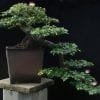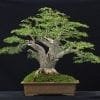Most people do not associate Rosemary with the art of bonsai, but this savory plant can be used for more than just seasoning. The hardy, fast-growing nature of this plant makes it an excellent choice for the bonsai gardener who wants a lovely bonsai tree without the complications often involved with bonsai gardening.
An added bonus is that the leaves from the Rosemary Bonsai can be used for seasoning, so pruning the Rosemary Bonsai can yield ingredients that will spice up tomato sauce or soup.
While Rosemary Bonsais require relatively simple care, there are still steps bonsai gardeners must take in order to ensure the health of their Rosemary Bonsais.
| Scientific/Botanical Name | Rosemarinus Oficinus |
| Description | The rosemary plant is an aromatic herb that is indigenous to the Mediterranean region, as well as Asia. It is an evergreen plant, and it has a woody trunk and branches. The leaves are thin and needle-like. its use in cooking, and as a herbal medicine, harks back to ancient times. Some rosemary cultivars grow along the ground, and others grow in an upright fashion. |
| Position | Rosemary plants require at least six hours of overhead sunlight per day while actively growing. When it is grown indoors, it requires 12 hours of direct light each day. The plant exhibits some winter-hardiness, and may be grown successfully in USDA zone 7 areas. |
| Watering | The plant must be watered frequently, but it cannot tolerate wet feet. The ideal form of watering is to stand the pot in a tray of water and allow the plant to soak-up the water until the top of the soil is damp. At that point, the pot should be removed from the watering tray. Rosemary benefits greatly from regular misting with fertilizer that has been diluted to a weak strength. Misting promotes plant health and vitality. |
| Feeding | Feed the plant twice a year. Supplemental fertilizer should be applied once a week during the growing season. |
| Leaf and Branch Pruning | Eliminate and dispose of dead branches. To encourage the plant to remain desirably small, remove all new growth that occurs beyond the first set of leaves. It is also vital that roots are pruned to retain the trees small stature. Trim away one quarter of the root growth at the side and at the bottom. |
| Re-potting & Growing Medium | Re-pot in loose, quick-draining soil. After re-potting, mist the tree with water. A soil that contains one-fifth organic matter and four-fifths aggregates is the ideal choice for growing rosemary bonsai trees. |
| Wiring | Wiring can only be carried out on young, flexible growth. Older growth is extremely brittle and not amenable to being bent. |
| Notes | Each spring, the tree produces blue or lavender flowers that are nicely aromatic. Rosemary bonsai trees can be decorative features while also being sources for herbal seasoning that enhances the flavor of lamb, chicken and pork. |
Planting & Placing
Rosemary Bonsais should be planted in loose, fast-draining soil so that the roots will not become oversaturated. Once planted, the Rosemary Bonsai should be placed in an area that receives full sunlight for at least six hours a day during the Rosemary Bonsai’s growing season and at least two hours a day during the rest of the year.
If gardeners wish the Rosemary Bonsai to stay indoors, then they will need to make sure that the Rosemary Bonsai has access to about twelve hours of full sunlight to compensate for not being outdoors.
The Rosemary Bonsai will benefit from being placed outdoors once the threat of winter frost has passed, although bonsai gardeners should pay close attention to the soil moisture levels once the Rosemary Bonsai tree has been relocated.
Watering
While Rosemary Bonsais are hardy trees, they require frequent watering in order to flourish. These bonsai trees should be planted in a well-draining pot since their roots are sensitive to over-watering, but gardeners should not go more than two days without watering their Rosemary Bonsais.
As with other plants, bonsai gardeners should be able to tell when the Rosemary Bonsai needs watering by the relative lightness or darkness of the soil; lighter soil means that the bonsai tree is drying out and requires watering.
The best method of watering a Rosemary Bonsai is to place the plant in a tray of one to two inches of water and soak the plant for an hour, removing once the soil is thoroughly moistened.
Rosemary Bonsais also benefit from absorbing water through the leaves, so misting water as well as fertilizer on the leaves themselves daily will help the Rosemary Bonsai remain healthy.
Fertilizing
Gardeners should fertilize their Rosemary Bonsais every six months with additional fertilizations every other week during the growing season. Rosemary Bonsais react well to various types of fertilizers, although gardeners should be careful to not overpower their bonsai trees.
Some experts recommend using regular plant fertilizer at half strength, while others recommend using high phosphorus fertilizer or organic fertilizer.
As with regular watering, Rosemary Bonsais will benefit from receiving mild fertilizer through the leaves.
Ridding the Rosemary Bonsai of Pests
Rosemary Bonsai trees can be susceptible to fungi and pests, so bonsai gardeners may need to spray their bonsai trees with fungicides or non-toxic pesticides.
A lack of adequate sunlight can lead to a Rosemary Bonsai contracting a white, powdery fungus, and spider mites, aphids, and other bugs may also plague this bonsai tree. Gardeners should use a sulphur-based fungicide or a non-toxic pesticide soap to rid their Rosemary Bonsai trees of such fungi and pests.
Pruning
When most people think about bonsai trees, they often envision the bonsai gardener pruning his trees with painstaking precision. Rosemary Bonsais are hardy enough that pruning poses little danger to them, but gardeners should still be cautious not to cut back to bare wood on anything but a healthy specimen.
Gardeners should always remove any branch that has died completely; Rosemary Bonsais often experience branch death when the tree is overtaxed, so removing the dead branch helps reduce the stress put on the tree.
These dead trimmings should not be consumed, but healthy trimmings can be dried and used for seasoning. In order to keep the Rosemary Bonsai appropriately small, gardeners should allow one set of Rosemary leaves to open and then prune out any new growth that sprouts beyond that initial set of leaves.
Pruning the Roots of a Rosemary Bonsai
Root pruning is essential to maintaining the small size of any bonsai tree, and the Rosemary Bonsai is no exception to this common bonsai need. Gardeners should trim approximately a quarter of the Rosemary Bonsai root growth every spring, cutting evenly on the bottom and around the sides.
The Rosemary Bonsai should then be repotted in fresh, well-draining soil; in order to prevent the Rosemary Bonsai from going into shock, the tree should be misted with water and soaked in a mixture of water as well as a shock-reducing treatment.
Why Choose the Rosemary Bonsai?
In addition to the savory nature of the Rosemary Bonsai leaves as seasoning, the Rosemary Bonsai also produces lovely, aromatic blue flowers during the Spring.
Rosemary Bonsai trees are relatively easy to cultivate and, unlike more complicated bonsai trees, can be shaped into a nice-looking bonsai tree within one year. Those familiar with Rosemary’s opinions may also be able to find this plant growing in the wild, meaning that the only cultivation costs will be those of upkeep and care.
Rosemary also had medicinal properties and is associated with helping prevent and treat cancer, liver disease, and asthma. The plants themselves are considered insect repellants, so setting these out in the garden will help keep insects away.
The art of bonsai is all about trimming and aesthetic beauty, but it also involves redefining and reshaping not only the tree itself but also the human perception of the tree.
Most people see Rosemary as a culinary means to an end, but Rosemary Bonsai tree gardeners see the multi-purpose appeal of reshaping and reforming this plant into an artistic object. Fortunately for Rosemary Bonsai gardeners, their artistic object can also be used to season the chicken.


